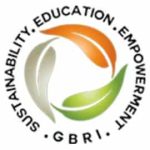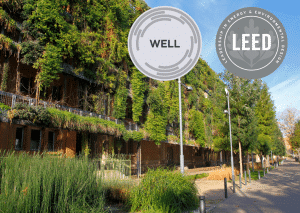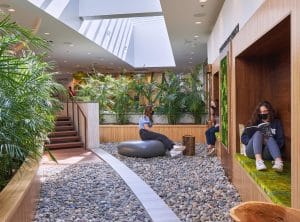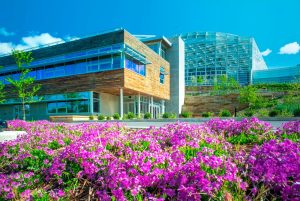In the ever-evolving landscape of sustainable design, where new technologies emerge and scientific research continuously reshapes our approach to building design, the LEED Innovation category stands as a testament to forward-thinking and eco-friendly practices. This category is not just a component of the LEED framework; it is a celebration of creativity and environmental stewardship in design, construction and operation. It acknowledges and rewards the innovative efforts of project teams that extend environmental benefits beyond the established LEED credit categories; Location and Transportation, Sustainable Sites, Water Efficiency, Energy & Atmosphere, Materials & Resources, and Indoor Environmental Quality.
Crafted as a versatile and dynamic category, LEED Innovation is designed to commend exemplary performance and ingenuity in green building. The US.Green Building Council (USGBC) recognizes the ever-changing nature of the green building industry and the necessity to incentivize novel advancements that push the boundaries of what is possible.
The ethos of this category is to broaden the scope of green building by integrating novel techniques, processes, and products into project development. It is in the DNA of the LEED rating system to foster innovation as an organic outcome of its comprehensive and iterative processes. This approach not only promotes new methods and standards but also propels the entire practice of green building into new territories of excellence.
Diving into the Credits of the LEED Innovation Category
Encompassing a maximum potential of six points, the LEED Innovation category maintains a uniform point distribution across all project types. It is comprised mainly of two credits: one for innovation, offering three distinct options, and another for the inclusion of a LEED AP on the project team.
Credit 1 – Innovation (1-5 points)
The core intent of the innovation credit is to spur projects towards achieving exceptional or innovative performance. This credit is universally applicable, offering up to five points. The options under this credit are as follows:
1. Option 1: Innovation (1 point) – This option rewards strategies not explicitly covered by any LEED prerequisite or credit, yet demonstrate significant sustainable benefits. To earn points here, projects must exhibit considerable, measurable environmental performance using a novel strategy not addressed in the LEED rating system. For each strategy pursued, the team must clarify the intent, compliance requirements, submittals for compliance, and the design strategies employed.
2. Option 2: Achieve a Pilot Credit from USGBC’s LEED Pilot Credit Library. Pilot credits are proposed credits that serve as a testing ground for new strategies before potential inclusion in LEED.
3. Option 3: Exemplary Performance (1-2 points) – This option allows for earning points by significantly surpassing the requirements of existing LEED prerequisites or credits. For instance, achieving 50% indoor water savings, instead of the standard 40%, could earn an additional point.
Throughout GBRI’s exam preparation materials, icons of thumbs up and thumbs down indicate whether a credit is eligible for exemplary performance.
Project Variations within the Innovation Category
For Core and Shell projects, the pursuit of Innovation credits necessitates a comprehensive strategy that often encompasses the entire building, including core, shell, common areas, and tenant spaces. For example, to gain an Innovation credit for a green housekeeping program, the base building management of the Core and Shell project must control or enforce the cleaning standards through legally binding agreements for areas beyond its immediate control.
http://www.usgbc.org/pilotcredits
Innovation in LEED: A Collaborative Journey Towards Sustainable Excellence
Q: Who shoulders the responsibility for this credit? The LEED Innovation credit is a collective endeavor, embraced by every member of the project team. This integrated team spans various professions, as vividly illustrated in the accompanying graphic. When teams push the boundaries of LEED requirements through innovation, they not only reap additional environmental benefits but also contribute to the evolution of future LEED credits. Their groundbreaking work in exceeding standard LEED credit performance sets a precedent for others in the industry to follow.
Q: How is this Innovation credit implemented? The journey begins with identifying innovative strategies. Sometimes, these strategies exceed the benchmarks of existing LEED credits; other times, they introduce completely new sustainability benefits not previously covered. Sustainable design is born from such innovative thinking, and recognizing these efforts is key to environmental advancement. Innovation can spark at any phase of a project and from any team member, whether during initial meetings, design charrettes, or at later stages. The process involves exploring opportunities for innovative strategies, achieving exemplary performance, and researching and implementing pilot credits. It’s crucial to identify unique environmental strategies not currently addressed in LEED and discuss the possibility of integrating pilot credits or other innovative approaches.
Q: What does not qualify for innovative credits? It’s important to note that innovation credits are not granted merely for using specific products or design strategies that assist in attaining an existing LEED credit. Also, strategies that are closed pilot credits and not listed in the online Innovation database are ineligible. A strategy cannot earn more than one point under Innovation, meaning it cannot be double-counted for multiple achievements. The innovation must be project-specific and not a broad corporate strategy. Teams should reference the online Innovation database for examples of successful innovation credits, but these do not guarantee future approval for similar strategies. Formal preapproval requires a project credit interpretation request (CIR).
The Second Credit under the ID Category: Innovation Credit – LEED Accredited Professional
This credit highlights the pivotal role of a LEED Accredited Professional (AP) in the seamless integration and implementation of LEED within a project. The presence of a LEED AP with specialty is invaluable, offering insights into the LEED rating system, the interplay of prerequisites and credits, and guiding the LEED application process. To earn this credit, at least one principal participant of the project team must be a LEED AP with a relevant specialty. Their credential must be active and not expired at the time of certification review. Legacy LEED APs without specialty do not qualify for this credit.
CASE STUDY: CHARTWELL SCHOOL, SEASIDE CA
This private school, catering to students with learning differences such as dyslexia, stands as the first LEED Platinum School and a Net Zero Building. The project team focused on reducing energy demand, effective use of photovoltaics, and strategic daylighting to enhance focus and minimize glare. The school’s green features are not just functional; they are integrated into the curriculum, allowing teachers to use the energy dashboard system to show students the school’s energy usage in real time, turning the building itself into a dynamic educational too.
As you prepare for your LEED exam, consider these sample questions as a glimpse into the depth and scope of the examination. As an esteemed USGBC Education Provider, GBRI is dedicated to ensuring that our students not only face their LEED exams with confidence but also excel in them on their first attempt. We invite you to discover more about our comprehensive exam preparation resources and the scholarship opportunities we offer, designed to empower your journey towards becoming a LEED-certified professional.
Q. If a commercial building project is targeting points for innovative performance, how could it achieve the desired points?
Answer choices
1. Implementing a strategy not addressed by the LEED rating system
2. Meeting the requirements of a LEED credit
3. Addressing geographically specific environmental priorities
4. Exceeding the requirements of a LEED credit
Correct answer – Implementing a strategy not addressed by the LEED rating system
The other choices are;
• Meeting the requirements of a LEED credit – Meeting the requirements of a LEED credit would only earn that credit.
• Addressing geographically specific environmental priorities – Addressing geographically specific environmental priorities can earn a Regional Priority credit, not an Innovation in Design credit.
• Exceeding the requirements of a LEED credit – Exceeding the requirements of a credit provides an opportunity for earning exemplary performance under Innovation in Design, not innovative performance.
The purpose of our blog series is to enlighten our readers about specific sustainability categories within the LEED rating system, elucidating their practical application in project settings and potential representation in LEED examinations, whether for Green Associate or AP credentials. As integral components of GBRI’s LEED Lexicon Project, these blogs serve as a beacon of knowledge for those navigating the realms of sustainability and green building. We warmly invite our readers to utilize the provided tags to delve into related topics and encourage a subscription to our page for regular updates and insights.


















